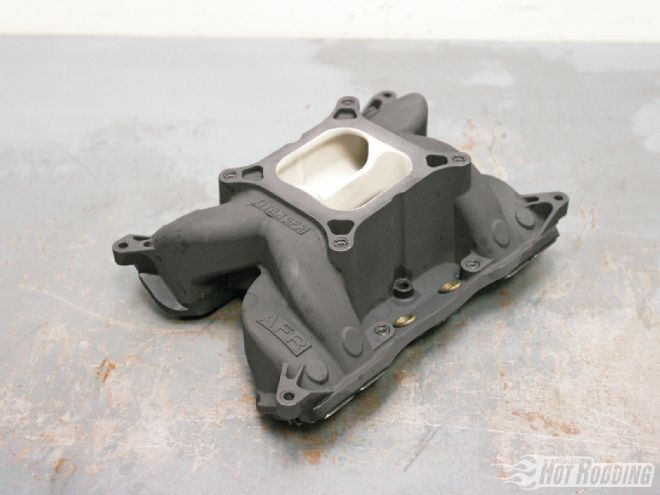
Given the over 50 years of development time, you might think that every possible variation of small-block Chevy intake manifold has been done. When Air Flow Research decided to introduce a line of intake manifolds to complement its industry-leading cylinder heads, as you might imagine, innovation was a key objective. Here the company looked at the latest trends in OEM manifold manufacture, and the direction was clearly spelled out. Composite construction from polymer materials has entered the forefront, replacing traditional cast construction for this vital piece of the engine’s airflow system. The end product of this effort is AFR’s new Titan series of intake manifolds.
Why composites? Constructing a manifold from polymers offers technological advantages over a sand-cast component. For openers, because the polymer materials are molded in permanent dies, the precision of manufacture is substantially improved. What we get is a more consistent net shape to blueprint specifications, eliminating the inconsistencies of casting flash and core shift. The process produces identical parts every time, with smooth and clean surfaces throughout. This ensures that each runner will deliver the performance that it was designed for, without the variations that can rob horsepower. While composite material in the manufacture of intake manifolds seems to have many production advantages, the aftermarket has been slow to follow the OEMs in using this technique. The fact is that the tooling for such intake manifolds requires a much higher initial investment than that for a sand-cast aluminum component, making such a product a risky venture given the scale of aftermarket production. AFR showed the dedication to this technology that has made it a reality.
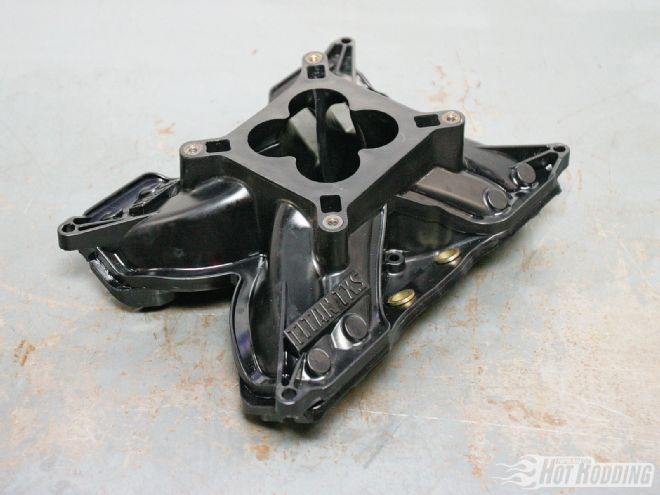
Just based upon the benefits noted above, composite manifolds seem to have enough going for them to be worth considering; however, this material has other advantages that make it naturally well suited to manifold construction. Of course, the obvious trait here is weight reduction. The composite material and construction techniques result in a manifold that is roughly half the weight of its aluminum counterparts, and when performance is the watchword, weight matters. Considering that the weight is ultimately removed from a high up and forward location on most vehicles, that is an advantage that translates to both straight line and handling applications.
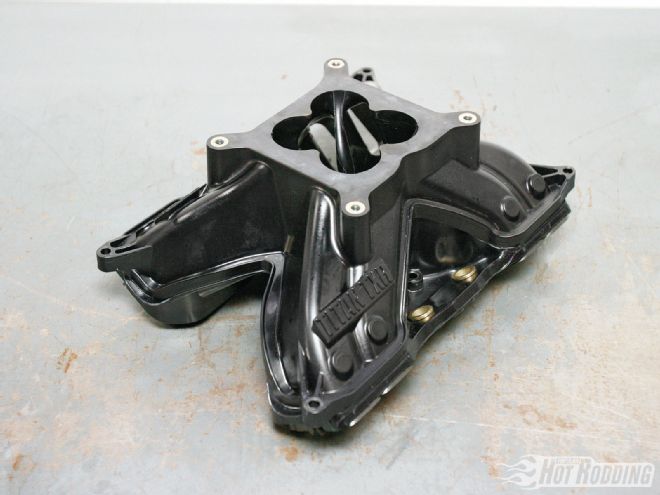
Less weight is a good thing, but we are saving the best for last, and that is the thermal properties of the composite material. Herein lays perhaps the key performance advantage of the polymer manifold. It is no secret that a cooler induction charge of air/fuel is one that packs more combustibles into the cylinder and makes more power. Everything from cool cans to iced-down intake manifolds is employed on the track in an effort to shave temperature from the charge in search of more power. In fact, at the AMSOIL Engine Masters Challenge event, some competitors go to extreme lengths to insulate the intake manifold from engine heat. The reality is that aluminum is a material that is a remarkable conductor of heat, literally soaking heat from any available source and rapidly discharging it to the mixture. This is why aluminum is a favored material for heat exchanges such as automotive radiators. This counterproductive trait of aluminum is one of the things that we have had to live with in intake manifold applications.
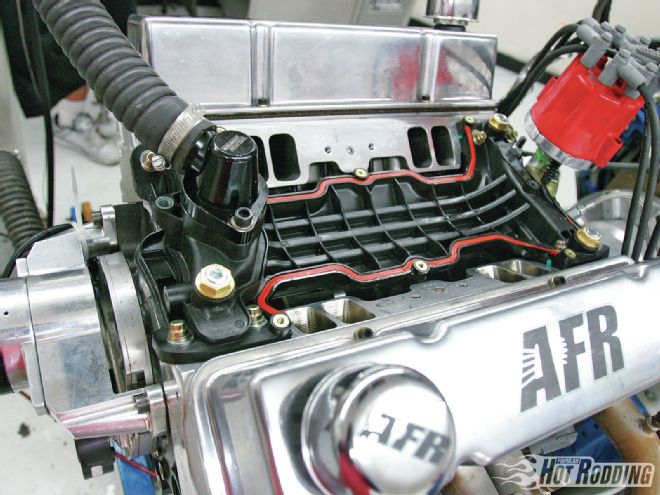 A key innovation with the AFR Titan manifold system is the universal baseplate assembly. Once the base is installed, numerous manifold configurations can be bolted on without having to disturb either the water passages or the distributor.
A key innovation with the AFR Titan manifold system is the universal baseplate assembly. Once the base is installed, numerous manifold configurations can be bolted on without having to disturb either the water passages or the distributor.
In contrast, a polymer material is a natural insulator, often used as the basis for insulating spacers and heat barriers. With a polymer manifold the heat transfer into the air/fuel mixture is dramatically reduced, allowing the latent heat of vaporization in the manifold to do its magic to cool the intake charge. In theory this characteristic leads to more power, and in a high-performance application, that is the ultimate goal. Tests at AFR show that the Titan polymer manifold runs 30 degrees cooler than conventional aluminum manifolds.
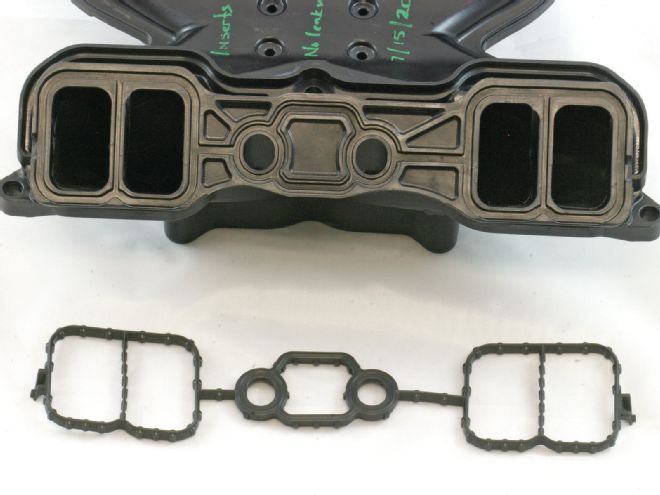 Sealing is taken care of by molded rubber seals. These are reusable and extremely effective. With the full sealing system in place, no path is open to oil seepage at the cylinder heads.
Sealing is taken care of by molded rubber seals. These are reusable and extremely effective. With the full sealing system in place, no path is open to oil seepage at the cylinder heads.
Just based upon the material, a favorable case can be made to recommend the AFR intake manifolds, but the innovation didn’t stop there. The engineers at AFR looked to add other design features that take this manifold system to the next level. The most striking of these features is the two-piece construction, consisting of a separate baseplate and spider assembly. The baseplate mounts to the intake valley, and houses the distributor and water crossover, while up top the runners and plenum are built into a separate spider molding. This configuration allows the spider to be removed or swapped without disturbing the distributor or draining the coolant.
AFR currently has three spider assemblies available for their Titan series of small-block Chevy manifolds, including the Titan DPR, a dual-plane street/strip layout, the street/strip TXS single plane, and the TXR high-rise race single-plane. Any of these manifold configurations can be swapped on a common baseplate, and the swap can be completed in just minutes since the baseplate (and distributor) can remain in place on the engine. To aid sealing, The Titan manifolds took a cue from the latest OEM sealing technology and feature molded rubber seals rather than conventional gaskets. These seals fit in precision-molded retention channels in the manifold, and are crush-limited by the fastener configuration for a perfect seal every time. The system virtually eliminates the potential for fuel, vacuum, coolant, or oil leaks.
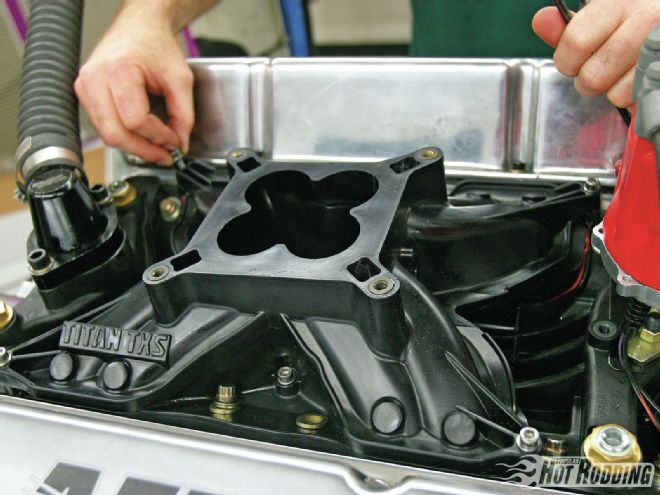 The TXS single-plane is designed as a high-performance street/strip manifold. Thanks to the two-piece configuration, we had the two-plane off and the single-plane cinched down in under five minutes.
The TXS single-plane is designed as a high-performance street/strip manifold. Thanks to the two-piece configuration, we had the two-plane off and the single-plane cinched down in under five minutes.
We had a chance to run all three of the Titan manifold configurations on a 372ci street small-block equipped with AFR street 195cc heads. These three configurations are designed to cover the needs of most conventional small-block Chevy engines, from street to serious race. The dual-plane DPR showed the broadest torque curve while retaining excellent power production into the higher rpm ranges. With the single-plane TXS, we saw the textbook trade in low-end torque for higher rpm output that would be expected when swapping from a single-plane to a dual-plane manifold. This would be the ticket for combinations where top end power trumps low-end torque requirements, such as applications with high-stall torque converters that never see the lower end of the rpm range. The TXR high-rise single-plane is designed for serious engines, and the moderate power of our street/strip engine wasn’t really at a level that would demand an intake of that capacity. Interestingly, the TXR race did show a power gain compared to the smaller TXS, even with our moderate combination. On a serious big-inch small-block, we’d expect even bigger power gains with the TXR.
We did find that the Titan offered unrivaled ease of installation compared to conventional small-block Chevy manifolds. On the dyno, we worked through the three manifold configurations in record time, without the hassle of draining the coolant, or pulling and retiming the distributor. The sealing system performed as expected, without spilling a drop of messy liquid on our stout small-block. We have to hand it to AFR for taking the lead in technology with the Titan, breathing the newest in manifold technology into the familiar small-block.
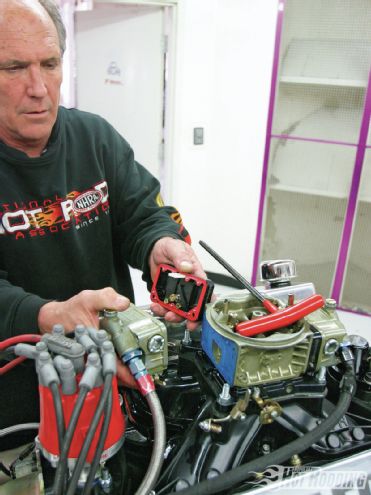 As might be expected, we found the single-plane required a minor jetting adjustment to optimize the air/fuel ratio. Westech’s Steve Brulé stepped up the jetting at the rear of the carb by three sizes.
As might be expected, we found the single-plane required a minor jetting adjustment to optimize the air/fuel ratio. Westech’s Steve Brulé stepped up the jetting at the rear of the carb by three sizes.
The Engine
While 372 ci might seem like an unusual combination, the bottom end of our engine is based upon a Dart SHP short-block assembly, offered with a bore and stroke of 4.125 inches and 3.480 inches. Featuring all forged internals, this big-bore, short-stroke combination is virtually bulletproof, and it delivers a compression ratio of 10.5:1 with the AFR 195cc street heads on our motor. Valve action is provided by a COMP 242/248-degree duration at .050 hydraulic roller cam. While the cubes are moderate compared to some of the common longstroke combinations, the power output and willing rpm make this a standout piece.
Dyno Results
AFR Titan Manifolds 373ci small-block Chevy
Torque Horsepower RPM DPR TXS TXR DPR TXS TXR 3,000 396 385 390 226 229 223 3,200 409 390 396 249 238 241 3,400 435 409 413 282 265 267 3,600 452 425 432 310 291 296 3,800 463 436 445 335 316 322 4,000 475 452 458 362 344 349 4,200 485 462 470 388 370 376 4,400 489 469 477 410 393 400 4,600 489 474 481 428 415 422 4,800 487 476 485 445 435 443 5,000 485 480 488 461 457 465 5,200 484 484 489 479 479 484 5,400 481 483 488 495 497 502 5,600 473 477 480 505 509 512 5,800 465 470 470 513 519 519 6,000 456 461 462 521 527 528 6,200 445 451 453 525 533 535 6,400 431 440 443 525 536 540 6,600 414 427 430 520 537 540